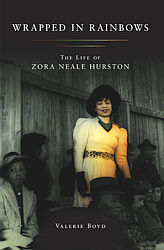
From Wrapped in Rainbows by Valerie Boyd. Copyright © 2003 by Valerie Boyd. Reprinted with permission of Scribner, an imprint of Simon & Schuster, Inc., NY. (Available for purchase on Amazon.Com.)
By all accounts, Zora Neale Hurston possessed a quality that enabled her to walk into a roomful of strangers and, a few minutes and a few stories later, leave them so completely charmed and so utterly impressed that they sometimes found themselves offering to help her in any way they could. Among those she thus impressed at the May 1, 1925, Opportunity magazine awards dinner were three people who had the power to help her immensely: Barnard College founder Annie Nathan Meyer, popular author Fannie Hurst, and novelist and man-about-town Carl Van Vechten. All three would become major champions of Hurston’s talent and instrumental forces in the development of her career.
Zora soon coined a term for people like them—influential whites who supported the New Negro movement and who took an interest in black life itself. Because their philanthropic interests had a distinct racial angle, they were not merely humanitarians, in Zora’s view. Instead, she called them “Negrotarians.”
Zora caught the attention of this particular trio of Negrotarians with little conscious guile, simply by being herself. What they saw of her at the Opportunity dinner convinced them that she was a brilliant young woman, luminous with intellectual and artistic promise. Within months, Zora had become a regular at Carl Van Vechten’s frequent interracial parties, and he had declared her “one of the most amusing people” he’d ever met. His friend Fannie Hurst concurred. Zora had “the gift,” she once said, “of walking into hearts.”‘
Annie Nathan Meyer’s response to Zora’s “gift” was swift and sensible: She approached her after the awards dinner and offered her a slot at Barnard, an independent women’s college affiliated with Columbia University.
Meyer had played a critical role in the founding of Barnard in 1889. Years before, as a Columbia University student, she had been disappointed to learn that the collegiate coursework offered to women was not as rigorous as the standard education for male students. Infuriated by this inequity, she had resolved to create an entire college for women in New York City. Within a few years, she had personally obtained much of the funding for the school through donations from her husband, Dr. Alfred Meyer, and from the likes of John D. Rockefeller.
Once Barnard was on firm footing, Meyer established her own career as a writer and soon became one of several Jewish philanthropists who offered a generous flow of cash to black organizations and causes. Others of this ilk included Urban League backer Julius Rosenwald (chief stockholder in Sears, Roebuck & Company), as well as Amy, Joel, and Arthur Spingarn, who provided years of financial support to the NAACP. These Jewish Negrotarians were not just curious about black life or intrigued by what some might have considered an exotic culture; rather, they were committed to black uplift, and their philanthropy was effusive. Commented one observer: “Being of use to the Negro was becoming virtually a specialty of the second most abused Americans of the early twentieth century.”
By 1925, when she met Zora, Annie Nathan Meyer was a well-ensconced Barnard trustee who felt it was time for the college to become a bit more colorful. And Zora Hurston seemed to have gumption and genius in equal measure—the perfect combination, Meyer believed, for crossing Barnard’s color barrier.



